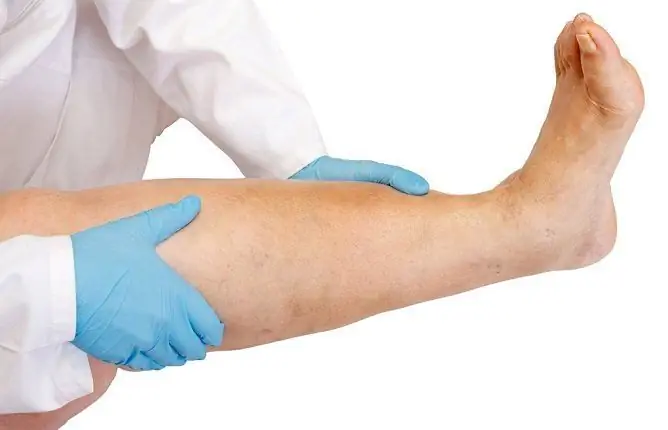- Author Rachel Wainwright [email protected].
- Public 2024-01-15 19:51.
- Last modified 2025-11-02 20:14.
Peripheral edema: what is it, symptoms and causes
The content of the article:
-
Peripheral edema
Peripheral edema - what is it?
- Possible reasons
- Symptoms
- Diagnostics
- How to treat pathology
- Video
Peripheral edema
Peripheral edema can occur for a variety of reasons, ranging from side effects of drugs, ending with heart or kidney disease. The symptom does not occur on its own, but often indicates a serious illness.
Puffiness is determined visually and by palpation - after pressing, a fossa remains (as seen in the photo).

Most often, peripheral edema develops in the legs and feet.
Peripheral edema - what is it?
Edema of peripheral tissues occurs due to the accumulation of water in the subcutaneous tissue. This is not a separate pathology, but a consequence of any disease.
Basically, swelling is localized on the legs, in the area of the legs and feet. Other localization is less common:
- face;
- neck;
- small of the back;
- upper limbs.
The mechanism of development can be different, and therefore there are several types of edema:
- Hydrostatic. Fluid retention is caused by an increase in hydrostatic pressure.
- Hypoproteinemic. They develop due to low levels of proteins in the blood.
- Inflammatory. They are caused by an increase in the permeability of the capillary wall.
Possible reasons
There are several reasons why peripheral edema develops. All of them are divided into systemic and local.
| Cause | Explanation |
| Heart failure | The reason is stagnation in the systemic circulation |
| Cirrhosis of the liver | Characterized by sodium and fluid retention and decreased protein synthesis |
| Kidney disease (renal failure, glomerulonephritis) | Caused by proteinuria, which is the loss of large amounts of protein in the urine |
| Side effects of medicines | Most often, calcium antagonists, which are used in the treatment of arterial hypertension, cause swelling. |
| Allergy | Pathology occurs due to inflammatory mediators, which lead to an increase in the permeability of the vascular wall |
| Hypothyroidism (decreased thyroid function) | Myxedema (mucous edema) develops due to the accumulation of mucopolysaccharides in peripheral tissues, which are able to bind and retain water |
| Deep vein thrombosis |
Thrombus formation is accompanied by venous hypertension, which leads to increased permeability of the blood vessel wall |
Symptoms
What is important to pay attention to when puffiness occurs:
- Development speed. If symptoms develop abruptly, within three days, the cause is most likely deep vein thrombosis. For other pathologies, symptoms progress more slowly.
- Localization. A lesion in only one limb indicates a local cause (eg, thrombosis or lymphedema). With heart failure, swelling of the legs is more common, with renal failure - of the face.
- Soreness. Most often, the edematous area is painless, but with thrombosis, there is severe pain in the affected limb.
- The time of day when the symptom is more pronounced. If the swelling goes away after a night's rest, this indicates venous insufficiency.
- The condition of the skin. With lymphatic edema, the skin over the affected area is compacted, with venous insufficiency - brown. In other cases, the skin does not change.
Fluid can accumulate not only in peripheral tissues, but also in body cavities:
- in the abdomen (ascites);
- in the chest cavity (hydrothorax);
- in the pericardial cavity (hydropericardium).
There are often other symptoms that indicate an underlying disorder. For example, pain in the heart and shortness of breath in heart failure, decreased urine output in case of kidney damage, etc.
Diagnostics
Peripheral edema is a reason to seek medical attention. The doctor will conduct a thorough examination: palpation of edema, auscultation of the heart and lungs, liver percussion.
If necessary, additional tests are assigned to help identify the cause of the pathological process.
| Research method | Indications for conducting, description |
| Electrocardiography, echocardiography | Allows you to identify violations of the cardiovascular system. |
| Biochemical blood test (renal and hepatic complex) |
An increase in creatinine levels indicates renal failure. Additionally, the level of blood proteins (albumin, globulins) is examined. An increase in the level of ALT, AST, a decrease in the prothrombin index indicates liver damage. |
| Hormonal blood test | A decrease in thyroxine and triiodothyronine, an increase in TSH indicate hypothyroidism. |
| Doppler ultrasonography of the lower extremities | It is prescribed to confirm the presence of venous thrombosis. |
How to treat pathology
The main direction of treatment is to eliminate the cause.
Regardless of the reason, it is necessary to correct the power supply:
- Reduce salt intake.
- Limit your intake of dairy and salty foods, especially before bed.
- The basis of the diet should be vegetables, fruits and proteins.
Symptomatic treatment consists in the appointment of diuretics - drugs that stimulate the excretion of fluid. Furosemide, Torasemide, Hypothiazide, Spironolactone are prescribed.
Prevention consists in undergoing medical examinations, timely treatment of diseases, adherence to a diet.
Video
We offer for viewing a video on the topic of the article.

Anna Kozlova Medical journalist About the author
Education: Rostov State Medical University, specialty "General Medicine".
Found a mistake in the text? Select it and press Ctrl + Enter.






